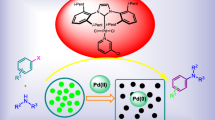Abstract
In order to achieve high-efficiency conversion of CO2 into valuable chemicals, and to exploit new applications of organobismuth compounds, cationic organobismuth complex with 5,6,7,12-tetrahydrodibenz[c,f][1,5] azabismocine framework was examined for the first time for the coupling of CO2 into cyclic carbonates, using terminal epoxides as substrates and tetrabutylammonium halide as co-catalyst in a solvent-free environment under mild conditions. It is shown that the catalyst exhibited high activity and selectivity for the coupling reaction of CO2 with a wide range of terminal epoxide. The selectivity of propylene carbonates could reach 100%, and the maximum turnover frequency was up to 10740 h−1 at 120°C and 3 MPa CO2 pressure when tetrabutylammonium iodide was used as co-catalyst. Moreover, the catalyst is environment friendly, resistant to air and water, and can be readily reused and recycled without any loss of activity, demonstrating a potential in industrial application.
Similar content being viewed by others
References
Sakakura T, Choi J C, Yasuda H. Transformation of carbon dioxide. Chem. Rev., 2007, 107 (6): 2365–2387
Yang H, Xu Z, Fan M, Gupta R, Slimane R B, Bland A E, Wright I. Progress in carbon dioxide separation and capture: A review. J. Environ. Sci., 2008, 20 (1): 14–27
Kasuga K, Kabata N. The fixation of carbon dioxide with 1,2-epoxypropane catalyzed by alkali-metal halide in the presence of a crown ether. Inorg. Chim. Acta, 1997, 257 (2): 277–278
Lu X B, Zhang Y J, Jin K, Luo L M, Wang H. Highly active electrophile-nucleophile catalyst system for the cycloaddition of CO2 to epoxides at ambient temperature. J. Catal., 2004, 227 (2): 537–541
Jing H, Nguyen S T. SnCl4-organic base: Highly efficient catalyst system for coupling reaction of CO2 and epoxides. J. Mol. Catal. A, 2007, 261 (1): 12–15
Kim H S, Kim J J, Kim H, Jang H G. Imidazolium zinc tetrahalide-catalyzed coupling reaction of CO2 and ethylene oxide or propylene oxide. J. Catal., 2003, 220 (1): 44–46
Li F, Xiao L, Xia C, Hu B. Chemical fixation of CO2 with highly efficient ZnCl2/[BMIm]Br catalyst system. Tetrahedron Lett., 2004, 45 (45): 8307–8310
Sun J, Fujita S, Zhao F, Arai M. Synthesis of styrene carbonate from styrene oxide and carbon dioxide in the presence of zinc bromide and ionic liquid under mild conditions. Green Chem., 2004, 6(12): 613–616
Xiao L F, Li F W, Peng J J, Xia C G. Immobilized ionic liquid/zinc chloride: Heterogeneous catalyst for synthesis of cyclic carbonates from carbon dioxide and epoxides. J. Mol. Catal. A, 2006, 253 (1-2): 265–269
Xiao L F, Li F W, Xia C G. An easily recoverable and efficient natural biopolymer-supported zinc chloride catalyst system for the chemical fixation of carbon dioxide to cyclic carbonate. Appl. Catal. A, 2005, 279 (1–2): 125–129
Kim Y J, Varma R S. Tetrahaloindate(III)-based ionic liquids in the coupling reaction of carbon dioxide and epoxides to generate cyclic carbonates: H-bonding and mechanistic studies. J. Org. Chem., 2005, 70 (20): 7882–7891
Zhao Y, Tian J S, Qi X H, Han Z N, Zhuang Y Y, He L N. Quaternary ammonium salt-functionalized chitosan: An easily recyclable catalyst for efficient synthesis of cyclic carbonates from epoxides and carbon dioxide. J. Mol. Catal. A, 2007, 271(1–2): 284–289
Lu X B, Zhang Y J, Liang B, Li X, Wang H. Chemical fixation of carbon dioxide to cyclic carbonates under extremely mild conditions with highly active bifunctional catalysts. J. Mol. Catal. A, 2004, 210 (1–2): 31–34
Lu X B, He R, Bai C X. Synthesis of ethylene carbonate from supercritical carbon dioxide/ethylene oxide mixture in the presence of bifunctional catalyst. J. Mol. Catal. A, 2002, 186 (1–2): 1–11
Sun J M, Fujita S I, Zhao F Y, Arai M. A highly efficient catalyst system of ZnBr2/n-Bu4NI for the synthesis of styrene carbonate from styrene oxide and supercritical carbon dioxide. Appl. Catal. A, 2005, 287 (2): 221–226
Ono F, Qiao K, Tomida D, Yokoyama C. Rapid synthesis of cyclic carbonates from CO2 and epoxides under microwave irradiation with controlled temperature and pressure. J. Mol. Catal. A, 2007, 263 (1–2): 223–226
Xie H, Li S, Zhang S. Highly active, hexabutylguanidinium salt/zinc bromide binary catalyst for the coupling reaction of carbon dioxide and epoxides. J. Mol. Catal. A, 2006, 250 (1–2): 30–34
Sun J, Wang L, Zhang S, Li Z, Zhang X, Dai W, Mori R. ZnCl2/phosphonium halide: An efficient Lewis acid/base catalyst for the synthesis of cyclic carbonate. J. Mol. Catal. A, 2006, 256 (1–2): 295–300
Paddock R L, Nguyen S T. Chemical CO2 fixation: Cr(III) salen complexes as highly efficient catalysts for the coupling of CO2 and epoxides. J. Am. Chem. Soc., 2001, 123 (46): 11498–11499
Jutz F, Grunwaldt J D, Baiker A. Mn(III)(salen)-catalyzed synthesis of cyclic organic carbonates from propylene and styrene oxide in “supercritical” CO2. J. Mol. Catal. A, 2008, 279(1): 94–103
Bu Z, Qin G, Cao S. A ruthenium complex exhibiting high catalytic efficiency for the formation of propylene carbonate from carbon dioxide. J. Mol. Catal. A, 2007, 277(1–2): 35–39
Suzuki H, Matano Y. Organobismuth Chemistry. Amsterdam: Elsevier, 2001
Gagnon A, St-Onge M, Little K, Duplessis M, Barabeì F. Direct N-cyclopropylation of cyclic amides and azoles employing a cyclopropylbismuth reagent. J. Am. Chem. Soc., 2007, 129(1): 44–45
Wu S S, Dai W L, Yin S F, Li W S, Au C T. Bismuth subnitrate as an efficient heterogeneous catalyst for acetalization and ketalization of carbonyl compounds with diols. Catal. Lett., 2008, 124 (1–2): 127–132
Bao M, Hayashi T, Shimada S. Cationic organobismuth complex with 5,6,7,12-tetrahydrodibenz[c,f][1,5]azabismocine framework and its coordination complexes with neutral molecules. Organometallics, 2007, 26 (7): 1816–1822
Author information
Authors and Affiliations
Corresponding author
Rights and permissions
About this article
Cite this article
Zhang, X., Dai, W., Yin, S. et al. Cationic organobismuth complex as an effective catalyst for conversion of CO2 into cyclic carbonates. Front. Environ. Sci. Eng. China 3, 32–37 (2009). https://doi.org/10.1007/s11783-008-0068-y
Received:
Accepted:
Published:
Issue Date:
DOI: https://doi.org/10.1007/s11783-008-0068-y




